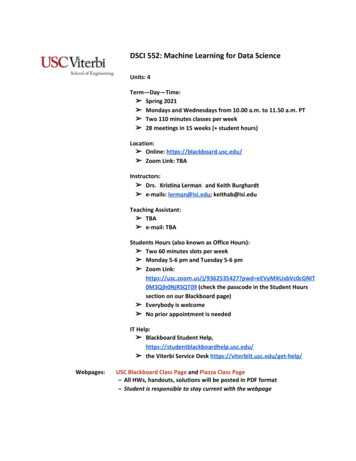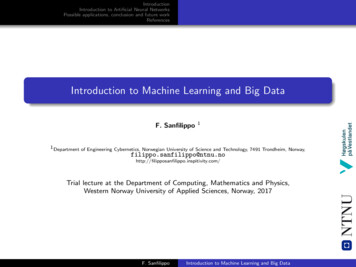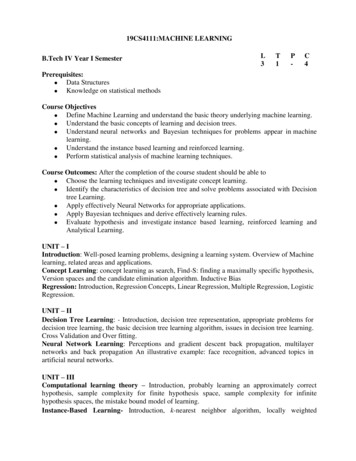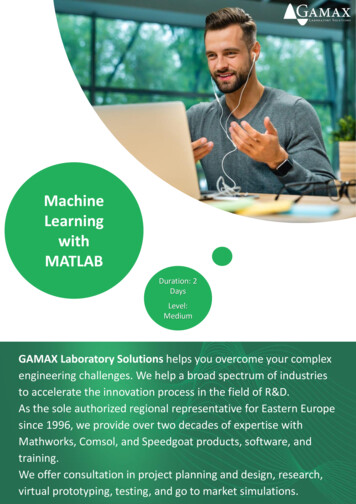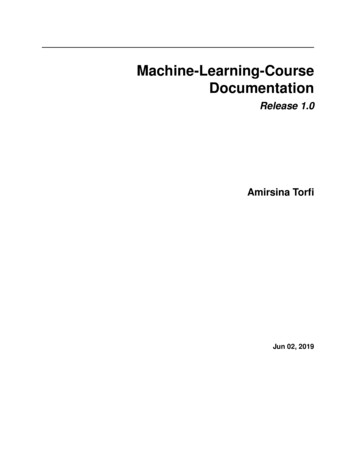
Transcription
Data Management in Machine Learning:Challenges, Techniques, and SystemsArun KumarMatthias BoehmJun YangUC San DiegoLa Jolla, CA, USAIBM Research – AlmadenSan Jose, CA, USADuke UniversityDurham, NC, USASIGMOD 2017
Who We AreArun KumarMatthias BoehmJun YangUC San DiegoLa Jolla, CA, USAIBM Research – AlmadenSan Jose, CA, USADuke UniversityDurham, NC, USABismarck ColumbusOrionHamlet
Motivation: A Data-Centric View of ML Application Perspective– Machine learning / advanced analytics / deep analytics Modern data-driven applications (e.g., BI, e-commerce, healthcare) Workload Perspective– Repetitive ML workflows– Often iterative ML algorithms– Often I/O-bound operations(e.g., matrix-vector multiplications)AttainableGFLOPs Systems Perspective– ML in data systems– DB-inspired ML systems– ML Lifecycle SystemsThisTutorial15-50xMem BandwidthPeakComputeOperational IntensityFLOPs/ByteCACM’09
Motivation: Systems tiMLDMacPhoton imSQLSystemMLMS (Rev) RDeepDiveZombieHPDistributed RRIOT-DBSAP okuLibFMTorchMatlabKeystoneMLJulia scikit-learn Sherlock noCNTKSparkMLSPSS VWMADlibSingaBismarckKerasSpark RDL4JSASFlink MLCaffeBUDS
Motivation: Tutorial Goals Overall Goal: Comprehensive review of systems and techniques thattackle data management challenges in the context of ML workloads #1 Categorize Existing Systems– ML in data systems, DB-inspired ML systems, ML lifecycle systems #2 Survey State-of-the-Art Techniques– Query gen, UDFs, factorized learning, deep DBMS integration– Optimization and runtime techniques, incl. resource elasticity– Model selection and model management Intended Takeaways– Awareness of existing systems and techniques– Survey of effective optimization and runtime techniques– Overview of open research problems
What this Tutorial is NOT Introduction to Machine Learning Tutorial on General-Purpose Systems– Dataflow systems– Graph-focused systems[SIGMOD’13][SIGMOD’16] Tutorial on Deep Learning– Deep learning algorithms– Deep learning systems (e.g., Torch, Theano, BigDL,TensorFlow, MXNet, CNTK, Singa, Keras, Caffe, DL4J)[SIGMODRecord’16] Tutorial on ML for RDBMS Internals– Cost models– Workload prediction (e.g., in Peloton)[CIDR’17]
Tutorial OutlineML in Data Systems 2 Query Generators and UDFs14min JY 3 Factorized Learning and Deep RDBMS Integration8min AKDB-Inspired ML Systems 4 Rewrites, Operator Selection, and Fusion14min MB 5 Compression, Scan Sharing, and Index Structures10min MB[ 6 Cloud Resource Elasticity10min JYML Lifecycle Systems 7 Feature Engineering, Model Selection/ManagementOpen Problems and Q&A16min AK]
2-1Part 2: ML with SQL & UDF“I suppose it is tempting, if the only tool you have is ahammer, to treat everything as if it were a nail.”Abraham Maslow, 1966Jun YangDuke UniversityDurham, NC, USASIGMOD ool-37063/
2-2ML in Database – Why? Convenience– “Elephants” (octopi?) have shown remarkable flexibility– A single platform for not only data management, transformation, andquerying, but also ML and application of insights Efficiency– Move the analysis, not data– Can co-optimize various steps involved in the “big data pipeline” Declarativeness– Simplifies development– Enables effective automatic optimization, which helps scalability/efficiency– One area where the DB community has plenty to offer
2-3Roadmap First, examples of what SQL can do for ML, at various levels ofabstraction:– Matrix multiply– Ordinary least squares– Gradient descent( See backup slides for– 𝑘𝑘-means– Markov-chain Monte-Carlo ) Then, a brief discussion of approaches to using SQL for ML
2-4Matrix Multiply: Take 1 Data: A(i,j,val), B(i,j,val)MAD Skills [VLDB'09]– Basically a sparse representation SELECT A.i, B.j, SUM(A.val*B.val)FROM A, BWHERE A.j B.iGROUP BY A.i, B.j;𝔸𝔸.i𝔹𝔹𝔹𝔹.j𝔸𝔸 Works pretty well for sparse matrices Not so good for dense matrices, but still beats “small-data” platformswhen data doesn’t fit in memory
2-5Matrix Multiply: Take 2MAD Skills [VLDB'09] Data: A(i,row), B(j,col)– row and col are ARRAY types or user-defined vector types– Basically a row-/column-major representation UDF (user-defined function): dotproduct(𝑣𝑣1 ,𝑣𝑣2 ) computes the dotproduct of two vectorsSELECT A.i, B.j, dotproduct(A.row, B.col)FROM A, B; Works fine for dense matrices But still suboptimal in terms ofcompute-to-I/O ratio𝑚𝑚ℓ𝕏𝕏𝑛𝑛ℓ 𝕐𝕐ℤ𝕏𝕏Computation: 𝑂𝑂 ℓ𝑚𝑚𝑚𝑚 , or volumeI/O: 𝑂𝑂 𝑚𝑚𝑚 ℓ𝑛𝑛 𝑛𝑛𝑛𝑛 , or surface Want instead “blocky” units tomaximize compute-to-I/O ratio Also note the change in representation (from input to output)
2-6Matrix Multiply: Take 3 Data: A(i,j,V), B(i,j,V)RIOT-DB [CIDR'09] SimSQL [ICDE'17]– V represents a submatrix; assume the dimensions are compatible– Basically a blocked representation UDFs– matmult(𝑉𝑉1 ,𝑉𝑉2 ) computes the product of two matrices– matsum(𝑉𝑉) is a UDA (user-defined aggregate) that sums up input matricesSELECT A.i, B.j, matsum(matmult(A.V, B,V))FROM A, BWHERE A.j B.iGROUP BY A.i, B.j; Choose a “big enough” V with good aspect ratio– E.g., square V’s beat skinny V’s UDFs can use optimized libraries like BLAS
2-7Ordinary Least Squares To fit data (𝑋𝑋, 𝑦𝑦) to a linear model𝑦𝑦 𝑋𝑋𝑋𝑋 𝜖𝜖:𝛽𝛽 𝑋𝑋 𝑇𝑇 𝑋𝑋 1𝑋𝑋 𝑇𝑇 𝑦𝑦 Computation involves basic matrix operatorsexpressible in SQL with help of UDFs– Inverse is tougher, but assuming the input matrix is small:– Code it as a UDF with memory-resident input– Processing won’t benefit from DBMS thoughhttps://en.wikipedia.org/wiki/File:Linear regression.svgMAD [VLDB'09, '12]SimSQL [ICDE'17]
2-8Observation How far can UDF and UDA go? Surprisingly very! UDF (oftentimes coded in other languages, e.g., Python and R)– Either on the tuple-level (invoked by SQL queries),– Or like an application program (invoking SQL queries) UDA– Init(state) initializes the state– Accumulate(state, data) computes updated state with new data– [optional] Merge(state, state) merges intermediate results computedover disjoint input subsets– Finalize(state) computes the final result from the state This pattern covers lots of iterative computation in ML, e.g.– 𝑘𝑘-means (backup slides) GLADE [LADIS'11,SIGMOD'12], MADlib [VLDB'12]– Gradient descent (next)
2-9Gradient Descent (GD) Given a model with parameters 𝑤𝑤, we want to learn from data 𝐷𝐷, i.e.,minimize a loss function 𝐹𝐹 𝑤𝑤; 𝐷𝐷– E.g., sum of loss over all training data a regularization term Start with some guess 𝑤𝑤0 In each step 𝑡𝑡 1, update 𝑤𝑤in the direction of the gradient ofthe loss function at 𝑤𝑤𝑡𝑡 , i.e., 𝐹𝐹 ′ 𝑤𝑤𝑡𝑡 Rinse and repeat Under certain (commonly held) conditions,GD converges to a local minimum– If 𝐹𝐹 is convex, that’s its global te descent.svg
2-10Stochastic GD (SGD) Suppose 𝐹𝐹 𝑤𝑤; 𝐷𝐷 is linearly separable over 𝐷𝐷– I.e., 𝐹𝐹 𝑤𝑤; 𝐷𝐷 𝑖𝑖 𝑓𝑓𝑖𝑖 𝑤𝑤; 𝑑𝑑𝑖𝑖 ,where 𝑖𝑖 iterates over the data points 𝐷𝐷 𝑑𝑑𝑖𝑖𝑖𝑖 Instead of updating 𝑤𝑤 using the “full gradient” computed over 𝐷𝐷 ineach GD step, just choose a single point in 𝐷𝐷– I.e., use 𝑓𝑓𝑖𝑖′ 𝑤𝑤 to approximate 𝐹𝐹 ′ 𝑤𝑤 Remarkably, for convex 𝐹𝐹 𝑤𝑤 , SGD also converges to the globalminimum, even if we pick points from 𝐷𝐷 in a fixed, arbitrary order– Albeit at a slower rate
2-11GD/SGD in SQL GD (full gradient)– Computation of full gradient over 𝐷𝐷 can be done by a query using UDA– Several options for driving outer loop– MADlib [VLDB'12] uses Python UDF– ScalOps [DeBull'12] uses Datalog– Underlying implementation is MapReduce instead of SQL SGD Bismarck [SIGMOD'12]– The entire procedure can be written as a query over 𝐷𝐷 using UDA—eachAccumulate() corresponds to one step
2-12MCMC in SQL MCMC (Markov-Chain Monte-Carlo) is a key method in Bayesian ML Bayesian ML comes down to analyzing the “posterior” distributionP(parameters, hidden variables observations) Direct analysis is often hard, so we use Monte-Carlo simulation– Repeatedly sample from the posterior, and analyze the samples But sampling directly from the posterior is often hard, so we use MCMC– A sampler generates a Markov chain of samples, whose stationarydistribution is the target posterior You can do Gibbs sampling (a form of MCMC) in SimSQL [SIGMOD'13]– With user-define “value-generating” functions that draw samples– See backup slides for details
2-13Approaches to SQL MLBackend choices “On top of” (e.g., RIOT-DB [CIDR'09], MAD [VLDB'09,VLDB'12]) vs.“inside” DBMS (e.g., SimSQL [ICDE'17]) Not DBMS, but still inspired by or rooted in DBMS– General-purpose “big-data” platform (e.g., SystemML [ICDE'11,VLDB'16],Cumulon [SIGMOD'13])– Specialized system from ground up (e.g., RIOT [ICDE'10], SciDB [CSE'13])Interface choices SQL libraries or extensions (e.g., MAD [VLDB'09,VLDB'12], SimSQL[ICDE'17], Oracle Data Mining, ) ML-oriented languages on top of SQL (e.g., RIOT-DB [CIDR'09],BUDS/SimSQL [SIGMOD'17], Oracle R Enterprise, )
2-14Interface: SQL Libraries/Extensions Especially nice with integrated model management, e.g.,Oracle Data Mining– Can create, store, update, and apply models in SQL-- Create model settings:CREATE TABLE svm settings(setting name VARCHAR2(30), setting value VARCHAR2(30));INSERT INTO svm settings VALUES(dbms data mining.algo name,dbms data mining.algo support vector machines);-- -- Build model:DBMS DATA MINING.CREATE MODEL(model name 'svm model',mining function dbms data mining.classification,data table name 'mining data build v',case id column name 'cust id',target column name 'affinity card',settings table name 'svm settings');-- Apply model:DBMS DATA MINING.APPLY(model name 'svm model',data table name 'mining data apply v',case id column name 'cust id',result table name ’svm apply result');
2-15Interface: no SQL Let user write whatever they are comfortable with (R, Python, etc.)– Provide a library of data manipulation and ML functions implemented bythe underlying system; can pre-compile user code– SQL underneath: RIOT [CIDR'09,ICDE'10], BUDS/SimSQL [SIGMOD'17],Oracle R Enterprise, etc.– Other “big-data” platforms underneath: SystemML [ICDE'11,VLDB'16],Spark R, Mahout Samsara, etc.Bayesian LASSO in BUDS in Mahout Samara(Examples from BUDS/SimSQL [SIGMOD'17]) in SystemML
2-16Summary You can get a lot ofmileage for machine learningwith SQL UDF (octopus hammer) Deep roots in– DBMS extensibility research– Array DBMS, e.g., SciDB [CSE'13]; see Rusu & Cheng [arXiv 2013] for survey Next: more opportunities for deeper ML DB e product/product&product id 115
2-17References for Part 2: ML with SQL & UDF Bismarck [SIGMOD'12] Feng et al. “Towards a Unified Architecture for in-RDBMS Analytics.” SIGMOD 2012 BUDS/SimSQL [SIGMOD'17] Gao et al. “The BUDS Language for Distributed Bayesian Machine Learning.” SIGMOD 2017 Cumulon [SIGMOD'13] Huang et al. “Cumulon: optimizing statistical data analysis in the cloud.” SIGMOD 2013 GLADE [LADIS'11] Rusu & Dobra. “GLADE: A Scalable Framework for Efficient Analytics.” LADIS 2011 GLADE [SIGMOD'12] Cheng et al. “GLADE: Big Data Analytics Made Easy.” SIGMOD 2012 MAD Skills [VLDB'09] Cohen et al. “MAD skills: new analysis practices for big data.” PVLDB 2(2), 2009 MADlib [VLDB'12] Hellerstein et al. “The MADlib Analytics Library or MAD Skills, the SQL.” PVLDB 5(12), 2012 RIOT-DB [CIDR'09] Zhang et al. “RIOT: I/O-efficient numerical computing without SQL.” CIDR 2009 RIOT [ICDE'10] Zhang et al. “I/O-efficient statistical computing with RIOT.” ICDE 2010 Rusu & Cheng [arXiv 2013] Rusu & Cheng. “A Survey on Array Storage, Query Languages, and Systems.”https://arxiv.org/abs/1302.0103 ScalOps [DeBull'12] Borkar et al. “Declarative systems for large-scale machine learning.” IEEE Data Eng. Bulletin, 35(2), 2012 SciDB [CSE'13] “SciDB: A Database Management System for Applications with Complex Analytics.” Comp. Sci. Eng. 15(3), 2013 SimSQL [SIGMOD'13] Cai et al. “Simulation of Database-Valued Markov Chains Using SimSQL.” SIGMOD 2013 SimSQL [ICDE'17] Luo et al. “Scalable Linear Algebra on a Relational Database System.” ICDE 2017 SystemML [ICDE'11] Ghoting et al. “SystemML: Declarative machine learning on MapReduce.” ICDE 2011 SystemML [VLDB'16] Boehm et al. “SystemML: Declarative machine learning on Spark.” PVLDB 9(13), 2016
2-18Part 2 Backup/Extra Slides
2-19𝑘𝑘-Means Clustering Given 𝑛𝑛 points, find 𝑘𝑘 centroids tominimize sum of squared distancesbetween each point and its closest centroid EM-style iterative algorithm:1.2.3.4.Pick initial 𝑘𝑘 candidate centroid locationsAssign each point to the closest candidateReposition each candidate as the centroid of its assigned pointsRepeat 2-3 above until assignment changes no more (or very ans-Gaussian-data.svg
2-20𝑘𝑘-Means as UDA State: 𝑘𝑘 candidates with locations cluster info⟨loc𝑖𝑖 , sum𝑖𝑖 , cnt 𝑖𝑖 ⟩ 1 𝑖𝑖 𝑘𝑘 Init: given centroid locations, with sum and count of 0 Accumulate: given a data point 𝑝𝑝, find the candidate 𝑖𝑖 closest to 𝑝𝑝;increment sum𝑖𝑖 by 𝑝𝑝’s coordinates and cnt 𝑖𝑖 by one Merge: merge ⟨loc, sum, cnt⟩ records by loc; add sum and cnt Finalize: for each 𝑖𝑖, compute new loc𝑖𝑖 as sum𝑖𝑖 /cnt 𝑖𝑖 One SQL query with this UDA givesone iteration of the EM algorithmGLADE [LADIS'11,SIGMOD'12]MADlib [VLDB'12]– For the next iteration, the UDA will be initializedwith the 𝑘𝑘 locations computed from the previous– Can use a UDF to drive overall iterations– Termination condition can be evaluated in SQL too (see MADlib)
2-21Markov-Chain Monte-Carlo (MCMC) Bayesian ML comes down to analyzing the “posterior” distributionP(parameters, hidden variables observations) Direct analysis is often hard, so we use Monte-Carlo simulation– Repeatedly sample from the posterior, and analyze the samples But sampling directly from the posterior is often hard, so we use MCMC– A sampler generates a Markov chain of samples, whose stationarydistribution is the target posterior
2-22Example: Gibbs Sampling Suppose we have an 𝑛𝑛-variate distribution, but the conditionaldistributions are easier to sample from Begin with some initial sample 𝕫𝕫0(𝑡𝑡 1) For the 𝑡𝑡 1 -th sample 𝕫𝕫 𝑡𝑡 1 , sample each component 𝑧𝑧𝑖𝑖conditioned on all other components sampled most recently, i.e.,(𝑡𝑡 1)𝑡𝑡 1𝑡𝑡 1𝑡𝑡𝑡𝑡𝑝𝑝 𝑧𝑧𝑖𝑖𝑧𝑧1, , 𝑧𝑧𝑖𝑖 1 , 𝑧𝑧𝑖𝑖 1 , 𝑧𝑧𝑛𝑛 Rinse and mpler-with-a-bivariate-normal-distribution/
2-23MCMC in SimSQLSimSQL [SIGMOD'13] Think of each sample as a table (tables) Write UDF to define “VG” (value-generating) functions that draw samples Write SQL with VG functions to define how to generate T[𝑡𝑡] (instance oftable T in the 𝑡𝑡-th sample) from T[𝑡𝑡 1] Write SQL to simulate multiple MCMC chains, and to compute computedistributional properties for variables of interest from T[𝑡𝑡]’s across T’s,𝑡𝑡’s, and chains An example of staying true to the declarative roots of databases– But also need new techniques not in traditional DBMS, e.g.:– Plans are huge—cut them into “frames”; observe execution stats of lastframe and to optimize the next– Use “tuple bundles” to instantiate/process multiple possible worldssimultaneously
Part 3: Learning Over Joins, SRL,and Deep RDBMS IntegrationArun KumarUC San DiegoLa Jolla, CA, USASIGMOD 2017
Overview: Learning Over JoinsMany datasetsProblem:are multi-tableJoinsML toolkits assumesingle-table inputsML afterjoining tablesOverheads:Extra storageComputational redundancyJoin timeMaintenance headachesLearning Over Joins: “Push Down” ML through joins1) Over standard data systems: Orion, Santoku, Morpheus2) Over a “factorized database” system: FDB-F3) Special-purpose tools: libFM, TensorDB, Compressed MLRelated but orthogonal: Statistical relational learning (DeepDive, etc.)
Learning Over JoinsOver standard data systems: Orion, Morpheus, SantokuExample: GLMs with gradient descent (GD)L(w) nXi 1f (w0 xi , yi )0wx rL(w) 0w S xS nXi 10w R xRg(w0 xi , yi )xix [xS xR ]Orion [SIGMOD’15]:T S ./ RIntroduced the scalable “factorized learning” ideaEasy UDA implementation on existing data systems (RDBMS/Hive/Spark)Morpheus [VLDB’17]:Generalizes factorized learning to any ML algorithm in linear algebra“Push down” rewrites for matrix-vector mult., gramian, ginv, etc.Santoku [VLDB’15]: Discrete features (Naive Bayes, trees, etc.)
Learning Over JoinsOver a “factorized database” system: FDB-F [SIGMOD’16]Generalized semiring-based aggregates over “factorized joins”
SRL; Deep RDBMS IntegrationSRL combines statistical learning with logic-based rules/constraints“Non-IID” ML models(MVDs, EMVDs, JDs)NIPS’12 tutorial by Lise GetoorBook with Ben TaskarInference and learning often perform joins internally!Scalable grounding using RDBMS: Tuffy [VLDB’10]Incremental maintenance: IncrementalDeepDive [VLDB’15]Increasing interest in deeper integration of ML into DBMS kernel!SAP HANA SLACID: Linear algebra kernels in an RDBMS [SSDBM’14]New compressed sparse row/col. representationsIntegrated API for basic access patterns and lin. alg. opsOpenMP-based shared memory parallelism in DBMS task scheduler
References: Part 3Columbus [SIGMOD’14]: Materialization Optimizations for Feature Selection WorkloadsDeepDive [DataEng’14]: Feature Engineering for Knowledge Base ConstructionFDB-F [SIGMOD’16]: Learning Linear Regression Models over Factorized JoinsIncrementalDeepDive [VLDB’15]: Incremental Knowledge Base Construction Using DeepDiveMorpheus [VLDB’17]: Towards Linear Algebra over Normalized DataOrion [SIGMOD’15]: Learning Generalized Linear Models Over Normalized DataSantoku [VLDB’15]: Demonstration of Santoku: Optimizing Machine Learning over Normalized DataSLACID [SSDBM’14]: SLACID - Sparse Linear Algebra in a Column-Oriented In-Memory Database SystemTuffy [VLDB’10]: Tuffy: Scaling up Statistical Inference in Markov Logic Networks using an RDBMS
Backup Slides
Statistical Relational Learning SystemsCaptures logical dependencies between between entities/variables“Non-IID” ML models(MVDs, EMVDs, JDs)PODS tutorial by Lise Getoor on Tue!(also NIPS’12; book with Taskar)Example: Markov Logic Network (MLN); used by DeepDiveMLN inference (MAP) computes “most probableworld” by plugging values of variables to predictGrounding SearchInvolves joins!Scalable grounding using RDBMS: Tuffy [VLDB’10]Scalable Gibbs sampling: Elementary [SIGMOD’13]Incremental maintenance: IncrementalDeepDive [VLDB’15]
Deep RDBMS IntegrationIntegrating linear algebra kernels into an RDBMS: SAP HANASLACID [SSDBM’14]: Mutable columnar layout for sparse matricesCompressed sparse row/col. representation incr. deltaIntegrated API for basic access patterns and lin. alg. opsOpenMP-based shared memory parallelism in DBMS task schedulerTime series-specific systems: Fa, F2DBFa [VLDB’07]: “Declarative forecasting” queries for time seriesProjection and shift-based time series feature transformationsFeature ranking and subset selection heuristicsLin. reg., Bayesian networks, SVM, CART, Random ForestBoth one-time and continuous forecasting
4-1Part 4: Rewrites, Operator Selection,and Operator FusionMatthias BoehmIBM Research – AlmadenSan Jose, CA, USASIGMOD 2017
4-2Overview Optimizing Compilersfor ML Algorithms Comparison Query OptimizationPL– Rule- and cost-based rewrites and operator ordering– Physical operator selection and query compilation– Linear algebra / other ML operators, DAGs,control flow, sparse/dense formats #1 Interpretation (operation at-a-time)– Examples: Morpheus [PVLDB’17] #2 Lazy Expression Compilation (DAG at-a-time)– Examples: RIOT [CIDR’09],Mahout Samsara [MLSystems’16]– Examples w/ control structures: Weld [CIDR’17],OptiML [ICML’11], Emma [SIGMOD’15] #3 Program Compilation (entire program)– Examples: SystemML [PVLDB’16],Cumulon [SIGMOD’13], Tupleware [PVLDB’15]DBHPCCompilers forLarge-scale MLOptimization 19:20:X read( 1); # n x m matrixy read( 2); # n x 1 vectormaxi 50; lambda 0.001;intercept 3;.r -(t(X) %*% y);norm r2 sum(r * r); p -r;w matrix(0, ncol(X), 1); i 0;while(i maxi & norm r2 norm r2 trgt){q (t(X) %*% X %*% p) lambda*p;alpha norm r2 / sum(p * q);w w alpha * p;old norm r2 norm r2;r r alpha * q;norm r2 sum(r * r);beta norm r2 / old norm r2;p -r beta * p; i i 1;}write(w, 4, format "text");
4-3Logical Simplification Rewrites Traditional PL Rewrites (e.g., TensorFlow, OptiML, SystemML)– CSE, constant folding, branch removal Algebraic Simplification Rewrites (e.g., SystemML, FAQ [PODS’16])––––t(X) %*% ytrace(X %*% Y)sum(X Y)sum(X 2)t(t(y) %*% X)sum(X * t(Y))sum(X) sum(Y)t(X) %*% X, iff ncol(X) 1 Loop Vectorization (e.g., OptiML, SystemML)for(i in a:b)X[i,1] Y[i,2] Z[i,1] Incremental ComputationsX[a:b,1] Y[a:b,2] Z[a:b,1]– Delta update rules (e.g., LINVIEW [SIGMOD’14], factorized [CoRR’17])– Incremental iterations (e.g., Flink)A t(X) %*% X t( X) %*% Xb t(X) %*% y t( X) %*% y– Update-in-place (e.g., SystemML)
Logical Simplification RewritesMatrix Multiplication Chain Optimization Optimization Problem– Matrix multiplication chain of n matrices M1, M2, Mn (associative)– Optimal parenthesization of the product M1M2 MnExamplet(X) %*% X %*% vt(X)1Kx1MX1Mx1K2,002 GFLOPs Search Space Characteristicsv1Kx1vs.t(X)1Kx1MX1Mx1Kv1Kx14 GFLOPs– Naïve exhaustive: Catalan numbers Ω(4n / n3/2))– DP applies: (1) optimal substructure, (2) overlapping subproblems– Textbook DP algorithm [MIT Press’09]: Θ(n3) time, Θ(n2) space– Examples: SystemML [Data Eng. Bull. ’14], RIOT (including I/O costs),SpMachO (including sparsity for intermediates) [EDBT’15],– Best known algorithm: O(n log n)4-4
Matrix Multiplication Chain OptimizationCost 501222432137215m[1,3] min(m[1,1] m[2,3] p1p2p4,m[1,2] m[3,3] p1p3p4 )i min( min(0 35 10*7*1,105,350 0 10*5*1 )400 )427500000M1M2M3M4M54-5
Matrix Multiplication Chain OptimizationCost 3501122243Optimal splitmatrix )33i3323344500000M1M2M3M4M5 Open questions: DAGs; other operations,joint opt w/ rewrites, CSE, fusion, and physical operators4-6( M1 M2 M3 M4 M5 )( ( M1 M2 M3 ) ( M4 M5 ) )( ( M1 ( M2 M3 ) ) ( M4 M5 ) ) ((M1 (M2 M3)) (M4 M5))
4-7Physical Rewrites and Optimizations Distributed Caching– Redundant compute vs. memory consumption and I/O– #1 Cache intermediates w/ multiple refs (Emma)– #2 Cache initial read and read-only loop vars (SystemML) Partitioning––––Many frameworks exploit co-partitioning for efficient joins#1 Partitioning-exploiting operators (SystemML, Emma, Samsara)#2 Inject partitioning to avoid shuffle per iteration (SystemML)#3 Plan-specific data partitioning (SystemML, Dmac [SIGMOD’15],Kasen [PVLDB’16]) Other Data Flow Optimizations (Emma)– #1 Exists unnesting (e.g., filter w/ broadcast join)– #2 Fold-group fusion (e.g., groupByKey reduceByKey) Physical Operator Selection
4-8Physical Operator Selection Common Selection Criteria– Data and cluster characteristics (e.g., data size/shape, memory, parallelism)– Matrix/operation properties (e.g., diagonal/symmetric, sparse-safe ops)– Data flow properties (e.g., co-partitioning, co-location, data locality) #0 Local Operators– SystemML mm, tsmm, mmchain; Samsara/Mllib local linalg #1 Special Operators (often fused operators)SelectionPreference– Special patterns (SystemML tsmm, tsmm2, mapmmchain, pmm; Samsara AtA– Sparsity exploiting (SystemML wdivmm, wsloss, wcemm; Cumulon maskMult) #2 Broadcast-Based Operators (aka broadcast join)– SystemML mapmm, mapmmchain #3 Co-Partitioning-Based Operators (aka improved repartition join)– SystemML zipmm; Emma, Samsara OpAtB #4 Shuffle-Based Operators (aka repartition join)– SystemML cpmm, rmm; Samsara OpAB
4-9Example Physical Operators Example Linear Regression Direct Solve––––Transpose-self for t(X)%*%XBroadcast-based for t(X) %*% yLogical and physical rewritesE.g., Samsara, SystemMLA t(X) %*% Xb t(X) %*% yw solve(A, b)t(b)fold(sum)fold(sum)Input pmm)broadcast()t(y)persist(MEM DISK)X
4-10Fused Operators Motivation– Problem: Memory-bandwidth-bound operations (I/O)– Goal: Reduce number of scans and intermediates Matrix-Vector Chains: t(X) %*% (X%*%v)– Fused single-pass operator: mmchain [PPoPP’15]– Row-aligned creation/consumption Ternary Aggregates: sum(X*Y*Z)Xsum– Fused aggregation operator– Avoid materialized intermediates Other ML-Specific Operators– Sample proportion: X * (1-X)– Sigmoid: 1 / (1 exp(-X))– Axpy: X s*Y, X - s*Y1stpass v* ZX * Y2ndpass qX
4-11Sparsity-Exploiting Fused Operators Goal: Avoid dense intermediates and unnecessary computation #1 Fused Physical Operators– E.g., SystemML [PVLDB’16]wsloss, wcemm, wdivmm– Selective computationsumover non-zeros of“sparse driver” #2 Masked Physical Operators– E.g., Cumulon MaskMult [SIGMOD’13]– Create mask of “sparse driver”– Pass mask to single maskedmatrix multiply operator Open questions: NaN handling,automatic operator fusion (codegen)sum(W * (X – U %*% t(V)) 2) 2W–X* UVO / (C %*% E %*% t(B))/mmmmCOMEt(B)
4-12Automatic Operator Fusion Motivation– Large development effort for hand-coded fused operators– UDF-centric systems w/o pre-defined operatorsR (A s*B) * Cfor( i intmp[i]for( i intmp[i]for( i intmp[i] General Approach: Fuse by Access Pattern– #1 Loop fusion (OptiML, Tupleware, Weld,TensorFlow XLA [github’17])– #2 Templates (Kasen, SPOOF [CIDR’17])– Scope: expression or program compilation Additional Techniques1:n ) s*B[i]1:n ) A[i] tmp[i]1:n) tmp[i]*C[i]for( i in 1:n )tmp[i] (A[i] s*B[i]) * C[i]– Tupleware: Micro optimizations (tile-at-a-time, predicates, result allocation)– Weld: Cross-library optimizations (via common IR of basic operations)– SystemML-SPOOF: sparsity-exploiting fused operators Open question: Optimization of fusion plans for DAGs(redundant compute vs materialization, access patterns)
4-13Runtime Adaptation (see AQP) Problem of Unknown/Changing Size Information– Dimensions/sparsity required for cost comparisons/valid plans– Unknowns conservative fallback plans Challenges– Conditional control flow, function call graphs, UDFs– Data-dependent ops (e.g., sampling, group by classes, output sparsity)– Computed size expressions, changing dimensions/sparsity Approaches– #1 Lazy expression optimization (RIOT, OptiML, Emma, Weld, Samsara)– Optimize on triggering actions (unconditional scope)– #2 Dynamic inter-DAG recompilation (SystemML)– Split/mark DAGs, recompile DAGs/functions w/ exact stats Open questions:– Estimating the size and sparsity of intermediates– Adaptive query processing and storage
References for Part 4 T. C. Hu and M. T. Shing: Computation of Matrix Chain Products. Part II. SIAM J. Comput. 13(2): 228-251, 1984. T. H. Cormen, et al. Introduction to Algorithms, Third Edition, The MIT Press, pages 370-377, 2009. Y. Zhang et al. RIOT: I/O-Ecient Numerical Computing without SQL. In CIDR, 2009. A. K. Sujeeth et al. OptiML: An Implicitly Parallel Domain-Specific Language for Machine Learning. In ICML, 2011. S. Ewen et al. Spinning Fast Iterative Data Flows. PVLDB, 5(11), 2012. B. Huang et al. Cumulon: Optimizing Statistical Data Analysis in the Cloud. In SIGMOD, 2013. M. Nikolic et al. LINVIEW: Incremental View Maintenance for Complex Analytical Queries. In SIGMOD, 2014. M. Boehm et al. SystemML's Optimizer: Plan Generation for Large-Scale Machine Learning Programs. IEEE Data Eng. Bull., 37(3), 2014. D. Kernert et al. SpMacho - Optimizing Sparse Linear Algebra Expressions with Probabilistic Density Estimation. In EDBT, 2015. A. Ashari et al.: On optimizing machine learning workloads via kernel fusion. In PPoPP, 2015. A. Alexandrov et al. Implicit Parallelism through Deep Language Embedding. In SIGMOD, 2015. Lele Yu et al. Exploiting Matrix Dependency for Efficient Distributed Matrix Computation. In SIGMOD, 2015. M. Abo Khamis et al.: FAQ: Questions Asked Frequently. In PODS, 2016. A. Crotty et al. An Architecture for Compiling UDF-centric Workflows. PVLDB, 8(12), 2015. M. Boehm et al. SystemML: Declarative Machine Learning on Spark. PVLDB, 9(13), 2016. M. Zhang et al. Measuring and Optimizing Distributed Array Programs. PVLDB, 9(12), 2016. S. Schelter et al. Samsara: Declarative Machine Learning on Distributed Dataflow Systems. NIPS Workshop MLSystems, 2016. T. Elgamal et al. SPOOF: Sum-Product Optimization and Operator Fusion for Large-Scale Machine Learning. In CIDR, 2017. S. Palkar et al. Weld: A Common Runtime for High Performance Data Analysis. In CIDR 2017. TensorFlow XLA, https://www.tensorflow.org/performance/xla/, 2017. M. Nikolic and D. Olteanu: Incremental Maintenance of Regression Models over Joins, CoRR, 2017. L. Chen et al. Towards Linear Algebra over Normalized Data. PVLDB, to appear, 2017.4-14
5-1Part 5: Compression, Scan Sharing, andIndex StructuresMatthias BoehmIBM Research – AlmadenSan Jose, CA, USASIGMOD 2017
5-2Motivation: Workload Characteristics Memory-Bandwidth-Bound Operations– Iterative ML algorithms w/ read-only data access– #1: I/O-bound matrix vector products Crucial to fit matrix into memory(single node, distributed, GPU) Avoid unnecessary scans– #2: Matrix and vector intermediates Reduce number of reads and writes Common Data Characteristics– Tall & skinny matrices(#row #columns)– Non-uniform sparsity– Low column cardinality– Column correlationsCovertypeXwhile(!converged) { q X %*% v }ImageNetMnist8m
5-3Motivation: Workload Characteristics Single N
tackle data management challenges in the context of ML workloads #1 Categorize Existing Systems - ML in data systems, DB-inspired ML systems, ML lifecycle systems #2 Survey State-of-the-Art Techniques - Query gen, UDFs, factorized learning, deep DBMS integration - Optimization and runtime techniques, incl. resource elasticity



